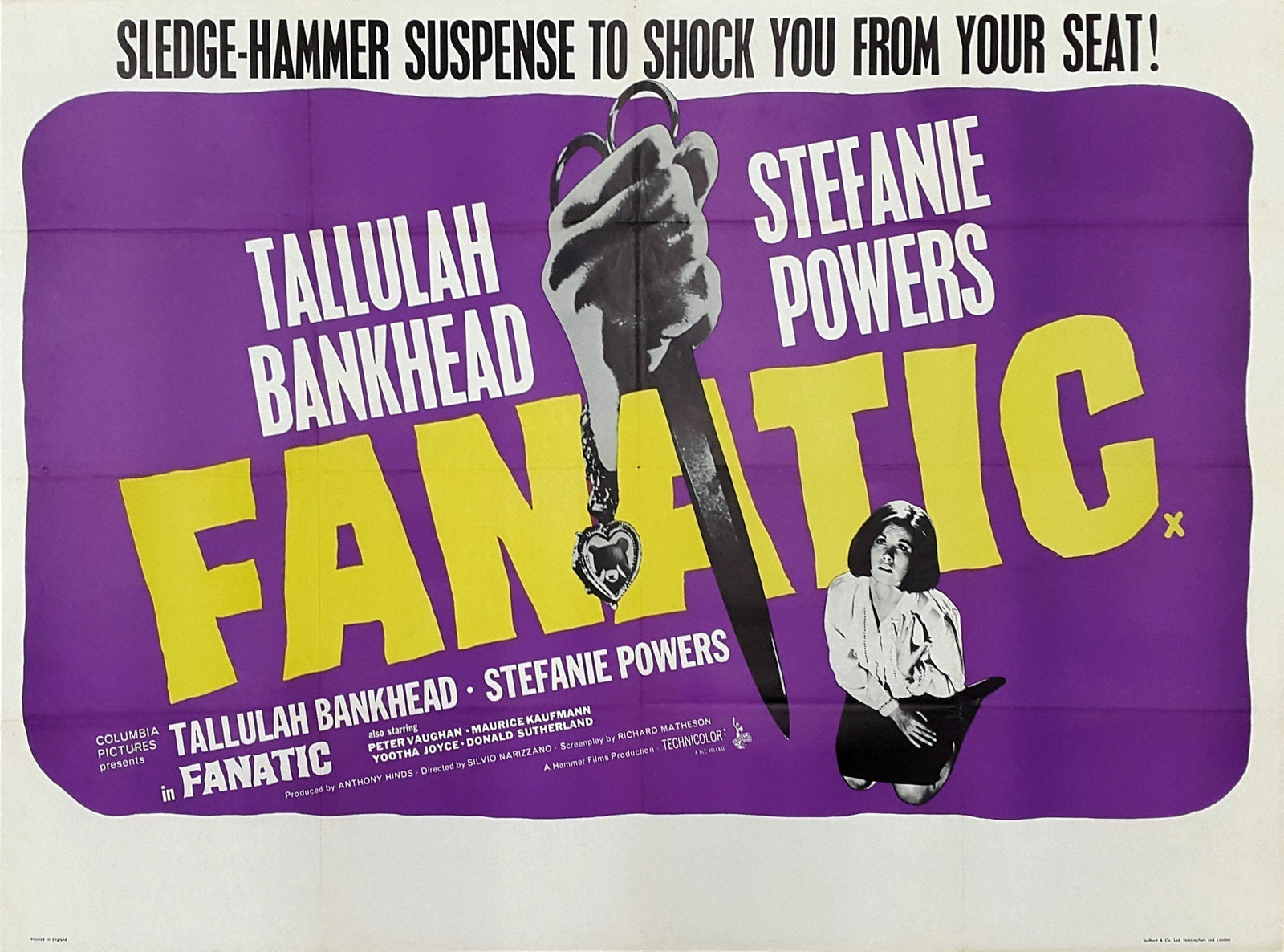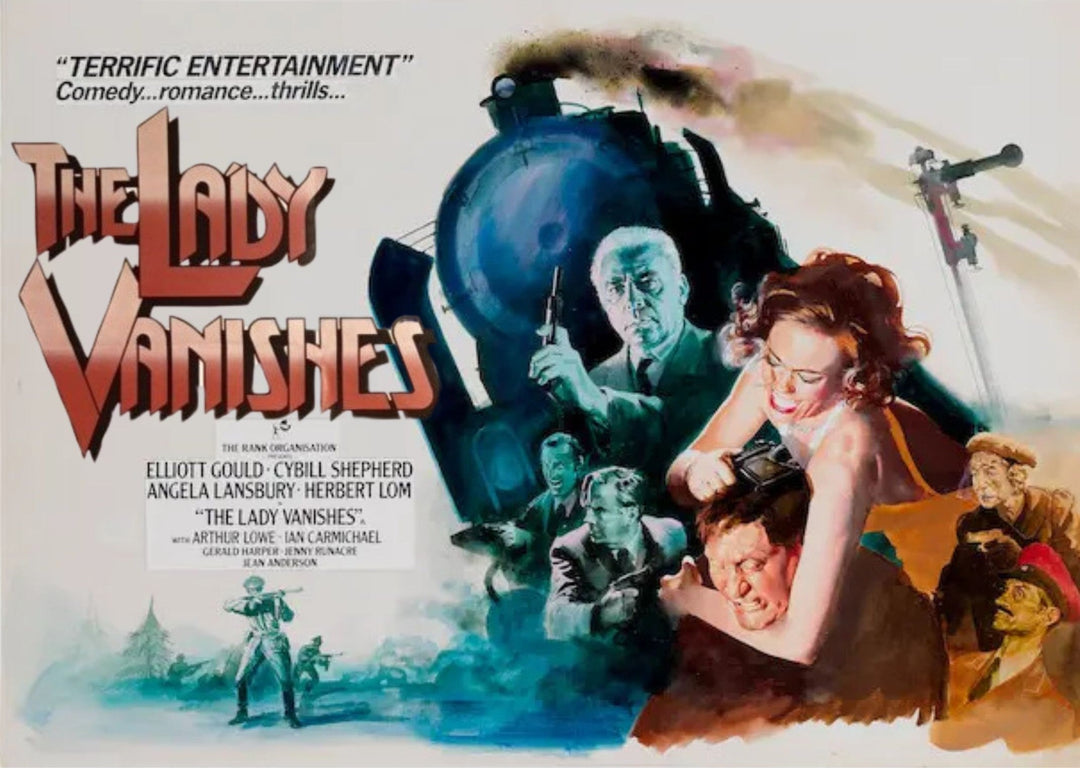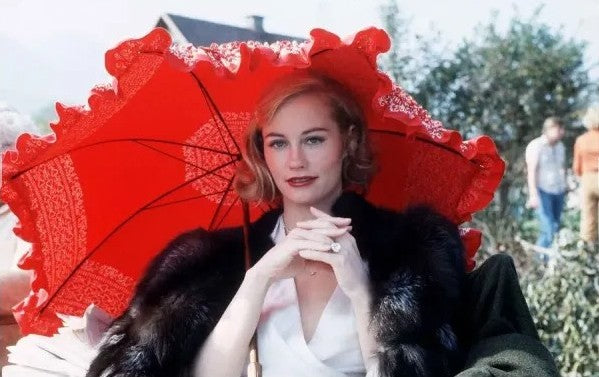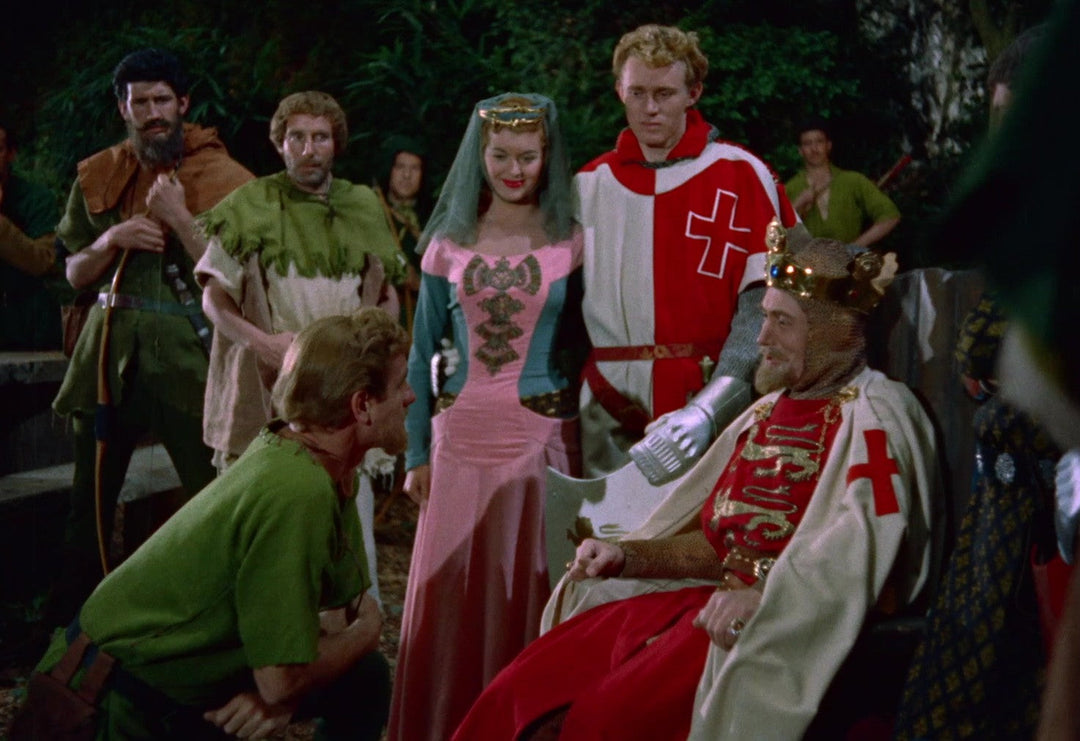Re-opening: Fanatic

Hammer’s horror-thriller, Fanatic (1965), known in the US as Die! Die! My Darling!, was released in March, 1965. We celebrate its sixtieth anniversary with a frank but affectionate look at what makes it such a fabulous, albeit flawed diamond of a film.
Fanatic opens with a young American, Patricia Carroll (a pre-Hart to Hart Stefanie Powers), visiting England with her new fiancé. Arriving in the UK she admits she’s promised to meet up with the mother (Tallulah Bankhead) of her former fiancé, who died in a road accident. She travels alone to Mrs Trefoile’s house – a large, sprawling old pile in the middle of nowhere. Alarm bells ringing yet? Loud and clear? Good! Because sure enough, it turns out her would-have-been mother-in-law is obsessed with the Bible, her guest’s virginity (or otherwise) and terrible modern evils, like lipstick and clothes that are the wrong colour. Or to borrow her handyman’s phraseology, ‘She is barmy.’
Mrs Trefoile’s ways and world view initially come across as eccentric and borderline humorous. ‘I can only rejoice that he died a virgin soul,’ she says, discussing her late son with his former lover. ‘So much more beloved!’ But pretty soon strange turns to sinister and Patricia finds herself trapped with an increasingly homicidal host. It’s a Hammer horror, so we can be fairly certain the ending won’t leave much room for Meet the Parent 2.

‘Is this a dagger which I see before me?’ Tallulah Bankhead as the cutting Mrs Trefoile.
Fanatic emerges as an unusual work, celebrated and castigated in equal measure. Critics invariably slate the way director Silvio Narizzano blends its humour and drama, whilst Tallulah Bankhead’s performance as the forceful Mrs Trefoile is lauded as the movie’s stand-out element. The New York Times wrote that Bankhead ‘towers above the cast and story’, The London Times called her ‘wonderful’, whilst Variety praised her ‘virtuosity’. All three are typical of the broader critical spectrum.
Bankhead’s alleged negativity towards Fanatic is also a common theme of many articles, and the oft-repeated claim that she only worked on the film for the Hammer paycheque is equally ubiquitous.
But it seems disingenuous to zone in on her dismissive attitude towards this picture, when she was openly dismissive of the vast majority of her output. ‘I have appeared in 35 plays,’ she revealed in her autobiography, ‘– only three of which had any merit.’ And with equal candour she claimed on multiple occasions that she only took any job for the fee that was being offered.
Wonderfully outspoken and outrageous, she was a wildly successful woman who downplayed her achievements. Although honest enough to concede, ‘…my performances have saved many a frowzy charade’ she professed to ‘loathe’ her profession (‘I detest acting because it is sheer drudgery.’) and was sceptical about ‘ersatz actors’ who pontificated about technique. ‘I could name them right here,’ she remarked wryly, again in her autobiography, ‘but… I have enough feuds on my hands.’
It's perhaps more instructive to remember that when ill-health threatened her presence in Fanatic, she convinced the producers she could and should continue, even putting up her salary for the film as a kind of insurance guarantee that she’d finish it. And later, back in the States, she organised personal screenings for her friends. These facts alone would suggest her jocular comments about the thriller were typical of her self-deprecating humour, rather than a genuine swipe at the movie itself.

The atmospheric artwork of the movie’s Spanish poster.
The claims that its humour is occasionally jarring are harder to refute. The problem often lies with the music which tends to stray into whimsical territory when darker strains would have complemented the underlying black humour. But in truth, there’s no out-and-out comedy. This is no The House in Nightmare Park (1973). The drollness in Fanatic is inherent within the situations it depicts, and often the sudden shift from humour to horror makes for an effective dramatic escalation.
When Patricia and Mrs Trefoile are sharing their first meal together, for example, it begins with a faintly amusing sequence of awkward moments. The food is served by an overly surly maid, and the hostess catches her guest off-guard with a long, over-the-top grace. When the food is revealed to be awful – through Stefanie Powers underplaying her character’s dismay – Patricia politely asks for salt. ‘We use no condiments of any kind in this house,’ she’s sternly informed. ‘God’s food should be eaten unadorned.’
It's impossible not to feel sorry for the young American at this point in the scene, but there’s been nothing to suggest imminent danger. Even when Mrs Trefoile misinterprets a stain on Patricia’s glass as a sign that her servant is slacking - ‘Anna… You have not washed up properly! There’s a mark on Miss Carroll’s glass!’ – the situation feels bizarre but unthreatening.
However, when Patricia reveals the smudge is from her lipstick, and makes light of it, Mrs Trefoile’s sudden rage is shocking as she commands her guest to, ‘Go and remove that filth at once!’ The atmosphere changes in a jolting instant. This is no longer a meal being served as a comedy of errors. It’s an insight into the mind of a controlling, fanatical zealot.
This evolution from weird to worrying epitomises several early scenes and the movie’s opening half-hour as a whole. Even when Patricia is locked in her room, she initially believes she’s up against someone who can be reasoned with. It’s only after she’s hurled a chair through the window and a gun is pulled on her that the truth begins to sink in.
Screenwriter Richard Matheson told Tom Johnson and Deborah Del Vecchio that, ‘When something strange happens to people, they’re going to respond. The situations were amusing to Powers [i.e. to Patricia] – only later did it begin to dawn on her what was going to happen.’
Tallulah Bankhead radiates star quality as the unhinged former actress and gets almost all the best lines. She remained a star in the 60s and was still a headline waiting to happen. Little wonder the critics shone the limelight so fixedly on her performance. She gives the movie a solidity and a sense of fun, but is equally terrifying and unholy. In other words, she’s a classic Hammer villain.

Much later, in 2013, Stefanie Powers played Tallulah Bankhead in the stage production, Looped.
But Stefanie Powers excels as the unfortunate who like Jonathan Harker in Dracula (1958) finds herself trapped in the home of a powerful fiend she struggles to understand. Her early exchanges with Mrs Trefoile form the story’s bedrock and each is an absolute treat. As the old woman’s lunacy leaks out, dripping like venom from a cracked vessel, Patricia constantly under-reacts. She’s trying to be courteous. Kind. A gracious guest unwilling to upset a still-grieving mother. But for every smile she fakes, her eyes give a look of, ‘What the hell have I got myself into?’
Powers also lends the character nuance and steel. After she’s been imprisoned and humiliated by Mrs Trefoile, she evidently enjoys her moment of minor vengeance as she reveals the friend she came to England with is ‘a man… a man… It’s the man I’m going to marry!’ This hits home and for once, the younger woman seems to have the upper hand.
Mrs Trefoile’s voice cracks as she demands to know, ‘Did you lie to me about being a virgin?’
And of all the answers she could supply - reassuring, pernicious or damning - Patricia replies with a single syllable. ‘Guess.’ The word is wielded like a blade.
Bankhead’s portrayal of her character’s surprise is enjoyable, but Powers’s quiet undulation from fear to vindictiveness makes the scene a compelling delight. The depth she gives Patricia ensures she’s much more than a victim-cipher. ‘Fanatic was a production I liked a lot,’ Matheson later recalled. ‘I thought Stefanie Powers was excellent.’ And who could disagree with that?
Several observers have noted the film’s interest dips in the middle, and they’ve got a point. In any horror, after the monster has been revealed, in this case Mrs Trefoile’s true self, the zenith of dreadful anticipation is past. With Fanatic, the film becomes a straight fight – Patricia versus her captors. The lengthy scenes where she’s chased by Harry, the lecherous home help, come across as unpleasant and obvious. Following the cut-and-thrust between Mrs T and her hostage, Harry’s leering pursuit feels a little dull, a little off pat, a little too Straw Dogs (1971).
Donald Sutherland is wasted as Joseph, the well-meaning gardener, but Yootha Joyce makes the most of her role as Anna, the conflicted maid who becomes her employer’s brutal enforcer. She’s torn by Mrs Trefoile’s lunatic orders yet feels as trapped as Patricia. Like any follower who doesn’t act on her doubts until it’s too late, she’s ultimately a tragic figure, and the moments where her humanity emerges, such as when she speaks to Joseph, make her descent all the more painful to watch.
The ending gives us a generous helping of edge-of-your-seat moments and a few Hitchcock touches that make for a gripping finale. It could be argued that Patricia lacks agency at the conclusion of her story, but perhaps that’s the point. When you’re at the mercy of a tyrant you need all the help you can get.

Mrs Trefoile’s nemesis – Patricia. When they met, it was murder.
Watching the film 60 years after it opened, another of its components, seldom touched upon around the time of its release, feels important. The movie is called Fanatic and Mrs Trefoile’s religious fanaticism drives its narrative. She remains blind to the absurdity of her beliefs, unwavering, even when they’re exposed as harmful.
Napoleon Bonaparte wasn’t kidding when he said, ‘There is no place in a fanatic’s head where reason can enter.’ and the intractable Mrs Trefoile is the embodiment of this. She’s reviled by scarlet clothes, but unmoved by the vivid red blood that pours from a wound she’s responsible for. She ensures her household is vegetarian but becomes a butcher. And her fanatic’s hypocrisy is perhaps most wittily held to the light as she reads the scriptures to Patricia, presiding over her prisoner, the Bible in one hand, a loaded gun in the other.
Mrs Trefoile may be a reclusive figure but her religious fervour means we’ve all seen her, on street corners holding a placard; on the world stage holding a mandate. She talks about love but shows no compassion. Forget her lackeys , her knife and her gun; her zeal and single-minded certainties are what make Mrs Trefoile so terrifying.
The year before Fanatic’s release, Hammer’s The Gorgon (1964) gripped audiences with its eponymous killer who could petrify victims simply by being seen. Megaera is a vile and striking sight with snakelike skin and vipers writhing in her hair. But Mrs Trefoile retains the ability to petrify without supernatural powers, and whilst looking like a respectable old woman. It’s not even a disguise, but her appearance lends her the perfect camouflage. She’s Little Red Riding Hood’s grandma and the Big Bad Wolf rolled into one. Cunning, self-centred and impervious to reason, she’s not a vampire, an ‘enemy from space’ or a gorgon. She’s much worse. She’s a fanatic.
This was director Silvio Narizzano’s first feature and immediately after his brief stint with Hammer he helmed the Oscar-winning rom-com, Georgy Girl (1966). Work in the US and Britain followed and he later enjoyed a successful career directing dramas as varied as Loot (1970) and the well-received The Body in the Library, a 3-part adventure for the BBC’s Miss Marple series. He won a BAFTA for his work on Court Martial and seemed to retain a fondness for his debut movie, later calling Bankhead ‘magnificent but impossible’.
The year after Fanatic’s release Stefanie Powers opened channel D and became April Dancer, better known as The Girl from U.N.C.L.E. The following decade she began playing the role she’d become most closely identified with, the glamorous Jennifer Hart in Hart to Hart. In the season 4 episode Harts on Campus, the sleuthing couple attend a school reunion and footage from Fanatic is used, intended to depict one of ‘Mrs H’s’ early am-dram efforts – unless there was something Jennifer wasn’t telling us…
Fanatic proved to be Tallulah Bankhead’s last appearance in a feature film. She continued acting however, and in 1967 starred in the TV series Batman, playing the Black Widow, a supervillain who uses a weapon that removes her victim’s ability to make independent decisions. One assumes Mrs Trefoile would have approved.
Six decades after it first beguiled audiences, her final starring role still thrills, chills and astonishes. It may have its flaws, but revisiting this sparkling horror in its diamond anniversary year, it’s hard not to be a fan of Fanatic.


